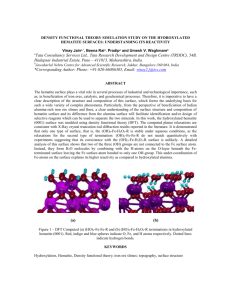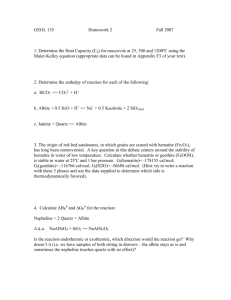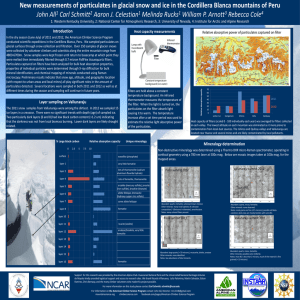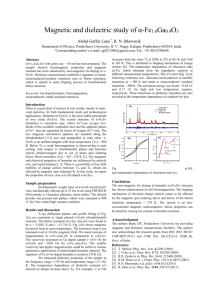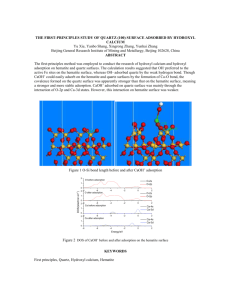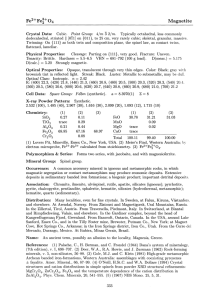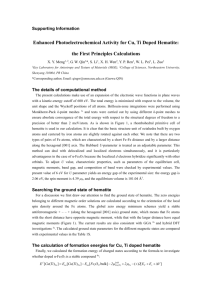Band-gap - DTU Orbit
advertisement
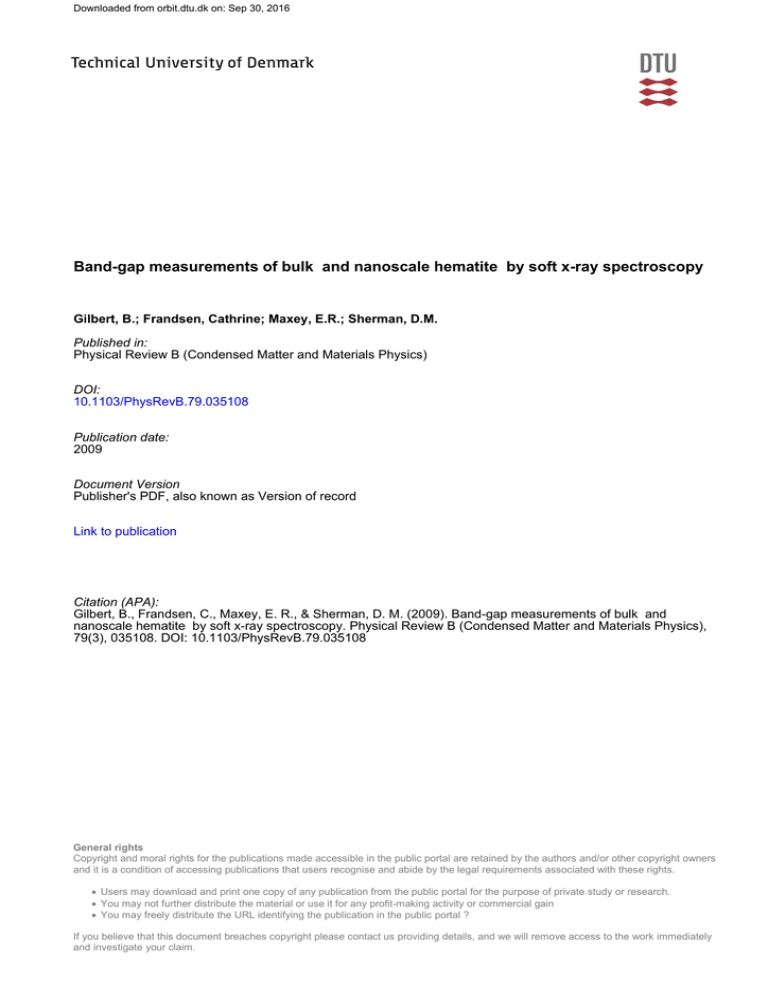
Downloaded from orbit.dtu.dk on: Sep 30, 2016 Band-gap measurements of bulk and nanoscale hematite by soft x-ray spectroscopy Gilbert, B.; Frandsen, Cathrine; Maxey, E.R.; Sherman, D.M. Published in: Physical Review B (Condensed Matter and Materials Physics) DOI: 10.1103/PhysRevB.79.035108 Publication date: 2009 Document Version Publisher's PDF, also known as Version of record Link to publication Citation (APA): Gilbert, B., Frandsen, C., Maxey, E. R., & Sherman, D. M. (2009). Band-gap measurements of bulk and nanoscale hematite by soft x-ray spectroscopy. Physical Review B (Condensed Matter and Materials Physics), 79(3), 035108. DOI: 10.1103/PhysRevB.79.035108 General rights Copyright and moral rights for the publications made accessible in the public portal are retained by the authors and/or other copyright owners and it is a condition of accessing publications that users recognise and abide by the legal requirements associated with these rights. • Users may download and print one copy of any publication from the public portal for the purpose of private study or research. • You may not further distribute the material or use it for any profit-making activity or commercial gain • You may freely distribute the URL identifying the publication in the public portal ? If you believe that this document breaches copyright please contact us providing details, and we will remove access to the work immediately and investigate your claim. PHYSICAL REVIEW B 79, 035108 共2009兲 Band-gap measurements of bulk and nanoscale hematite by soft x-ray spectroscopy B. Gilbert,1 C. Frandsen,2 E. R. Maxey,3 and D. M. Sherman4 1Earth Sciences Division, Lawrence Berkeley National Laboratory, MS 90R1116, 1 Cyclotron Road, Berkeley, California 94720, USA 2Department of Physics, Technical University of Denmark, DK-2800 Kongens Lyngby, Denmark 3Argonne National Laboratory, APS-XSD-XOR-CEP-11ID B, Building 433, Room D-009, 9700 South Cass Avenue, Argonne, Illinois 60439-4814, USA 4 Department of Earth Sciences, University of Bristol, Bristol BS8 1RJ, United Kingdom 共Received 16 June 2008; revised manuscript received 28 September 2008; published 12 January 2009兲 Chemical and photochemical processes at semiconductor surfaces are highly influenced by the size of the band gap, and ability to control the band gap by particle size in nanomaterials is part of their promise. The combination of soft x-ray absorption and emission spectroscopies provides band-gap determination in bulk and nanoscale itinerant electron semiconductors such as CdS and ZnO, but this approach has not been established for materials such as iron oxides that possess band-edge electronic structure dominated by electron correlations. We performed soft x-ray spectroscopy at the oxygen K-edge to reveal band-edge electronic structure of bulk and nanoscale hematite. Good agreement is found between the hematite band gap derived from optical spectroscopy and the energy separation of the first inflection points in the x-ray absorption and emission onset regions. By applying this method to two sizes of phase-pure hematite nanoparticles, we find that there is no evidence for size-driven change in the band gap of hematite nanoparticles down to around 8 nm. DOI: 10.1103/PhysRevB.79.035108 PACS number共s兲: 73.22.⫺f I. INTRODUCTION Hematite, ␣-Fe2O3, is the most common iron oxide in nature, and detailed understanding of electronic and magnetic properties of this material remains of considerable interest. Hematite nanoparticles have potential technological applications1 and are found in certain terrestrial1,2 and possibly Martian3 environments. Numerous investigators have studied the chemical and physical properties of iron oxide particles as a function of particle size with complementary methods such as static4,5 or ultrafast6–8 optical spectroscopies, x-ray9 and Mössbauer10 spectroscopies, neutron scattering,11 and tests of 共photo兲chemical12,13 or catalytic14 reactivity. Some of these studies have concluded that small particle size may alter the energy positions of the electronic states that define the semiconductor band gap.5,9,12,13 Bandgap widening is a striking signature of quantum confinement that has been observed in numerous semiconductor materials possessing delocalized electronic states close to the Fermi level.15 Enlarging the semiconductor band gap in nanoscale iron oxides would be of considerable importance for the use of this material in solar cells.16 However, the band-edge electronic structure of iron oxides is dominated by strongly localized Fe 3d states unlikely to experience spatial confinement even in nanoscale particles.17,18 Nevertheless, size, structure, and electronic properties are interrelated in nanoparticles, and the motivation of this study is to establish whether there are any size-dependent trends in the electronic structure of hematite that may explain the published results. We used synchrotron high-energy x-ray scattering and soft x-ray spectroscopy to study the structure and electronic properties of hematite samples of three particle sizes. Soft x-ray spectroscopy is well suited to investigate the electronic structure of bulk and nanoscale materials,19–21 and we employed oxygen K-edge absorption and emission spectroscopies to study valence-band and conduction-band electronic struc1098-0121/2009/79共3兲/035108共7兲 tures. While bulk hematite has been previously studied by O K-edge absorption and emission spectroscopies,22–25 we are not aware of similar studies of hematite nanoparticles. II. MATERIALS AND METHODS A. Hematite nanoparticle synthesis There are few methods for synthesizing hematite nanoparticles with chemical control of particle size. Nanoscale Fe2O3 is usually synthesized by an aqueous hydrolysis procedure in which a ferric iron oxyhydroxide precursor phase is dehydrated hydrothermally.26,27 As a consequence, as observed by us and by Hansen et al.,10 low-temperature processing can lead to material that is not phase pure. We used a multistage wet-chemistry synthesis procedure adopted from Sugimoto et al.28 which produces approximately pure hematite particles with diameters between 5–10 nm. The particles were confirmed to be single phase by the Mössbauer spectroscopy. The particles were washed and freeze dried before subsequent analyses. The characterization of a similar “asprepared” sample by the Mössbauer spectroscopy, transmission electron microscopy, x-ray, and neutron diffraction is described in Ref. 29 and discussed below. Samples of ⬃30 nm diameter hematite nanoparticles were produced by annealing commercial NANOCAT ultrafine Fe2O3 共MACH I, Inc., King of Prussia, PA兲 in air at 220 ° C. A sample of natural bulk hematite was purchased from Rocko Minerals 共Margaretville, NY兲. B. Optical spectroscopy A Cary 5G UV-vis-NIR spectrometer was used to acquire diffuse reflectance spectra from dried powders mounted on Teflon tape. The reflectivity data was converted to the Kebulk-Munk remission function, F共R兲, defined by F共R兲 = 共1 − R兲2 / 2R, where R is the reflectance. 035108-1 ©2009 The American Physical Society PHYSICAL REVIEW B 79, 035108 共2009兲 GILBERT et al. TABLE I. Hematite unit-cell parameters and particle size obtained from x-ray diffraction data. Bulk hematite 30 nm Fe2O3 8 nm Fe2O3 Error 5.027 13.732 ⬎100 Sphere 5.028 13.737 29 Sphere 5.028 13.769 7.8 Prolate spheroid 0.003 0.004 a共Å兲 c共Å兲 Particle diameter 共nm兲 Morphology C. X-ray diffraction analysis We performed powder x-ray diffraction 共XRD兲 at the Advanced Light Source 共ALS兲, Lawrence Berkeley National Laboratory, beamline 11.3.1, to determine the unit-cell parameters in bulk and nanoscale hematite. Dried powders were mounted on Kapton, and XRD was performed in transmission using a two-dimensional 共2D兲 detector. The scattering geometry was calibrated using a LaB6 standard, and the 2D data were integrated to one-dimensional 共1D兲 data using FIT2D.30 Instrument resolution was estimated using a National Institutes of Standards and Technology silicon standard. XRD data were analyzed using the MAUD code to refine hematite unit-cell parameters as well as particle size and shape parameters.31 D. Pair distribution function analysis We acquired wide-angle x-ray scattering data at 90 keV from powdered samples placed inside a hollow Kapton tube at beamline 11-ID-B of the Advanced Photon Source 共APS兲 at Argonne National Laboratory using a Mar 2D image plate detector. We acquired between 40 and 100 2 or 5 min exposure from an empty tube and each sample, using FIT2D, to calibrate the detector geometry using data acquired from a CeO2 reference and to bin each 2D pattern onto a 1D q axis. The structure factor for each iron oxide was obtained using procedures written in the IGORPRO package that subtract the Kapton data and the coherent and Compton atomic scattering contributions. The pair distribution function 共PDF兲 was generated by applying a sine transformation to the q-weighted data up to qmax = 25 Å−1 and was analyzed using the PDFGUI code32 to fit the structural and disorder parameters of bulk hematite to the real-space data between 1 – 32 Å. The finite data resolution parameter and quadratic correlated atomic motion term were obtained from the fit to the bulk hematite data and kept fixed during analysis of the nanoparticle samples. E. Soft x-ray absorption and emission spectroscopies Portions of finely ground bulk hematite and hematite nanoparticles were pressed into indium for soft x-ray spectroscopy analysis under vacuum. Oxygen K-edge x-ray absorption and resonant x-ray emission studies with threshold excitation were performed at beamline 7.0 at the ALS. The incident x-ray energy resolution was set to approximately 0.2 and 0.35 eV for absorption and emission spectroscopies, respectively. The x-ray emission spectrometer has a resolution of about 0.5 eV.33 In addition, O K-edge emission spectros- copy of bulk hematite was performed at ALS beamline 8.0 as a function of photon energy with similar energy resolution. The absorption spectra were acquired in fluorescence yield and were calibrated by applying a linear transformation to the energy axis to align the spectrum obtained from a TiO2 共anatase兲 standard to a published reference.34 Following this correction, the inflection point of the onset of the bulk hematite absorption spectrum was measured to be 529.7 eV, in good agreement with a recent study.21 The absolute energy calibration of the emission x-ray spectrometer was determined with reference to the Zn L2,3 emission lines from a zinc metal standard. The absorption spectra were normalized for the energy dependence of incident-beam intensity by the division of a gold grid electron yield signal acquired simultaneously with the sample and then scaled to unity step jump at 552.5 eV. The x-ray emission spectroscopy 共XES兲 spectra were normalized to a constant maximum intensity. III. RESULTS AND DISCUSSION A. Nanoparticle size and morphology Table I shows the results of particle size analysis derived from peak width broadening in the XRD data 共Fig. 1兲. The air-annealed iron oxide powder consisted of spherical particles of mean diameter 30 nm. No information was obtained as to the size distribution, which is expected to be broad. The best-fit particle morphology for the smallest nanoparticles was a spheroid elongated along the c axis with a minor axis diameter of about 8 nm. This finding is consistent with prior studies of hematite nanoparticles prepared using the same synthesis method, as described in Ref. 29. Transmission electron microscopy 共TEM兲 imaging showed individual particles to be spherical with a diameter in the range of 5–10 nm. However, hematite nanoparticles can grow by oriented aggregation to form single crystals that are elongated in the c-axis direction. Neutron-scattering studies showed that approximately one-third of the crystallites are joined in this manner, forming grains possessing an antiferromagnetic domain size of about three particle diameters along the c axis. B. Structural analyses Analysis of the XRD data 共Fig. 1 and Table I兲 revealed that relative to bulk hematite and 30 nm hematite particles the dominant structure modification in particles less than 10 nm in diameter is a small 共0.2%兲 enlargement of the unit-cell c parameter, causing a detectable shift in diffraction peak position 关inset in Fig. 1共a兲兴. Figure 2 presents the PDF data obtained from high-energy x-ray scattering data from all 035108-2 PHYSICAL REVIEW B 79, 035108 共2009兲 BAND-GAP MEASUREMENTS OF BULK AND NANOSCALE… (a) (a) (b) FIG. 1. Synchrotron powder XRD. 共a兲 Comparison of all XRD data. The inset shows a detectable lattice expansion in the smallest particles that is quantified by unit-cell refinement. 共b兲 Experimental and simulated XRD patterns for the best-fit results of unit-cell refinement to the 8 nm nanoparticle data. samples. Iron oxide synthesis in aqueous media can additionally form a fraction of a disordered nanoscale phase that is difficult to identify in XRD data but which leads to the appearance of peaks in the PDF pattern at short range that are not consistent with the hematite structure. This is not observed in any of the nanoparticle data, indicating that the samples are pure hematite. There are few signs of structural modifications in the hematite nanoparticles relative to the bulk material. PDF peak broadening in the short-range structure is perceptible at the second Fe-O shell as indicated in Fig. 2共a兲; an effect that is also associated with the larger values of the fit residuals for interatomic distances below 5 Å given in Fig. 2共b兲. This figure also shows that the attenuation of PDF peak intensity with increasing interatomic distance is slightly greater for the 8 nm sample, consistent with the smaller particle size.35 Table II reports the results of fitting a structural model based on the hematite unit cell to the PDF data. While the fitted cell parameters are systematically larger than those obtained from analysis of the diffraction data, the trend with size is identical. Because experimental structure factors can be affected by asymmetric instrumental broadening effects that are not removed before PDF generation, the lattice parameters obtained by the PDF analysis are usually not identical to those obtained by the Rietveld refinement of the diffraction data, which more accurately incorporates instrumental contributions to diffraction peak profiles.36 The trends in the fitted isotropic disorder factors for the oxygen and iron sites are difficult to interpret. The 30 nm particles (b) FIG. 2. PDF analysis of the real-space structures of bulk and nanoscale hematite. 共a兲 Stacked plot of the short-range region of the PDF curves. The vertical bar at approximately 3.4 Å highlights the third shell 共Fe-O兲 correlations that are slightly broadened in the 8 nm nanoparticles. 共b兲 Experimental 共markers兲 and best-fit 共dark line兲 PDF for all samples. Residuals 共dashed line兲 are given below each pattern. have the lowest disorder, likely resulting from the annealing step, while the metal site disorder is greatest in the 8 nm particles. The unexpected drop in oxygen site disorder in these samples likely indicates the presence of short-range strain not accounted for in the single unit-cell fitting approach. TABLE II. Structural parameters for bulk and nanoscale hematite obtained by analysis of the PDF data. We fitted the hematite unit-cell a and c parameters, the isotropic thermal factors, , for iron and oxygen atoms, and the mean iron-oxygen bond lengths, 具rFe-O典, calculated from the best-fit unit cell. Bulk hematite 30 nm Fe2O3 8 nm Fe2O3 Errora a 共Å兲 c 共Å兲 Fe 共10−3 Å2兲 O 共10−3 Å2兲 具rFe-O典 5.045 13.781 5.7 15.3 1.948 5.041 13.775 5.3 14.4 1.947 5.041 13.810 6.5 12.0 1.947 0.004 0.016 0.6 4.9 0.002 aThe reported errors 共standard deviations兲 were approximately the same for each of the samples. 035108-3 PHYSICAL REVIEW B 79, 035108 共2009兲 GILBERT et al. FIG. 3. The Kebulka-Munk function, F共r兲, obtained from UVvisible diffuse reflectance spectra of powders of bulk and nanoparticulate hematite. The vertical line indicates the inflection point in the nanoparticle absorption spectra determined from the first derivative plotted below, which lies at 562 nm 共2.2 eV兲. C. Optical spectroscopy Iron dd excitations and Fe-Fe pair excitations that occur throughout the visible photon energy range typically obscure the band-gap transition in optical-absorption spectra of hematite.37 The hematite band gap is more clearly discernable from measurements of photocurrent vs wavelength, and values of 2.14–2.2 eV for bulk samples are typical.38,39 As shown in Fig. 3, diffuse reflectance spectra of both 30 and 8 nm hematite exhibit an absorption threshold with an inflection point at 2.2 eV that we attribute to band-gap excitation. The equivalent spectrum from a sample of natural hematite does not exhibit an absorption threshold at this wavelength. However, the observed absorption onset of ⬃1.8 eV is attributed to charge-transfer excitations at coupled Fe2+-Ti4+ impurities that are commonly found in natural hematite and which mask the intrinsic band gap.40 Thus, the data of Fig. 3 indicate that the optical band gaps of samples that are around 30 or 8 nm in diameter are identical, and we tested this conclusion with x-ray spectroscopy. D. X-ray absorption and nonresonant emission spectroscopy of bulk hematite Soft x-ray spectroscopy at the O K-edge 共1s → 2p excitations兲 can be an accurate approach for revealing density of states in transition-metal 共TM兲 oxides because the ligand core hole created by photoexcitation is highly screened from the band-edge electronic states localized on the metal sites.22,24 Such screening lowers the complexity of the absorption spectra relative to TM L-edge 共2p → 3d兲 spectroscopy and reduces core hole effects on the energy positions of the excited states. Figure 4 shows O K-edge x-ray absorption spectroscopy 共XAS兲 and nonresonant XES data for bulk hematite that may be interpreted using prior theoretical studies.17,18 The characteristic pre-edge doublet in the absorption spectrum represents transitions to the unoccupied eg and t2g states. The nonresonant emission spectrum is derived from valence-band 共VB兲 states possessing O 2p character. Occupied antibonding Fe 3d-O 2p states lie at the top of the VB, which additionally contains nonbonding O 2p states, FIG. 4. Soft XAS and XES of bulk hematite at the oxygen K edge. 共a兲 The bulk hematite band gap, Eg, is determined from the XAS and nonresonant XES spectra by taking the derivative to locate the inflection points in the valence-band and conduction-band onsets. Using this approach, Eg = 2.2 eV. 共b兲 O K-edge XAS and resonant and nonresonant XES. and Fe-O bonds formed from O 2p and Fe 3d, 4s, and 4p orbitals. We tested several strategies for estimating the bulk hematite band gap using the data of Fig. 4. In previous studies of semiconductors such as CdS and ZnO, the VB maximum 共VBM兲 and conduction-band 共CB兲 minimum were identified as the band onset energy in, respectively, the emission and absorption data41,42 or were found by projecting to the abscissa a linear fit to the threshold regions.19,20 We find neither approach to be appropriate for iron oxide because both indicate the band gap to be less than 1 eV, significantly less than the commonly accepted value 共approximately 2.2 eV兲. Taking an alternative approach, the energy gap between the first inflection points of the XES and XAS spectra is measured to be 2.2 eV, in agreement with the inflection point of the optical-absorption spectrum 共Fig. 3兲. Thus, we propose this method as an internally consistent approach for determining the band gap from optical or x-ray spectroscopy of iron oxide and possibly for other semiconductors for which the band gap is defined by partially occupied d states. It is clear that VB states appear within the 2.2 eV gap, and lower-energy excitations are also evident in the optical spectra. However, 035108-4 PHYSICAL REVIEW B 79, 035108 共2009兲 BAND-GAP MEASUREMENTS OF BULK AND NANOSCALE… FIG. 5. Oxygen K-edge XES and XAS of bulk hematite and Fe2O3 nanoparticles. 共a兲 Comparison of XAS and XES data stacked vertically for clarity. 共b兲 Comparison of the XAS pre-edge region. 共c兲 Example peak fit to the pre-edge for the 8 nm nanoparticle sample. photoexcitation of hematite below 2.2 eV is not reported to cause detectable photoconductivity, and hence we conclude that excitations involving these VB states do not lead to efficient charge separation possibly due to extremely rapid recombination rates.6 E. Resonant x-ray emission spectroscopy of bulk hematite X-ray emission spectra acquired on an absorption resonance can contain energy-loss features due to coherent twophoton resonant Raman processes frequently called resonant inelastic x-ray scattering 共RIXS兲.43 RIXS processes are not subject to single-photon dipole selection rules and thus can excite electronic transitions that are forbidden in opticalabsorption spectroscopy. Hematite and manganosite 共MnO兲 are both 3d5 TM oxides, and metal L-edge RIXS measurements of these materials observe strong dd excitations.44,45 However, neither the validity nor accuracy of metal atom RIXS for band-gap determination in TM oxides have been fully established. A Fe L-edge RIXS study of single-crystal hematite attributed a weak RIXS peak at ⬃2 eV to be the bulk band gap.44 However, in a study of hematite nanorods, the same feature was weak or absent and a higher-energy peak was attributed to band-gap excitations.9 Moreover, the published RIXS spectra exhibit discrepancies in emission energy calibration. Oxygen K-edge emission spectra can also be acquired in a resonant mode although oxygen RIXS of hematite do not excite Fe dd transitions.46,47 Figure 4共b兲 shows bulk hematite valence-band XES data acquired with nonresonant excitation 共560 eV兲 and acquired resonantly at the XAS onset 共530 eV兲 and on the eg peak 共530.6 eV兲. The dominant trend is a loss of intensity at the VBM as the excitation energy is decreased. This trend strongly implies that hematite is an indirect gap semiconductor, as previously concluded by Dare-Edwards et al.39 and as found in the isostructural d0 oxide corundum 共␣-Al2O3兲.48 As a coherent two-photon process, a RIXS excitation must satisfy momentum conservation. Since the photon momentum is negligible, the band-gap excitations probed by RIXS are constrained to vertical transitions between bands in energy-momentum plots.49 Loss of intensity at the VB maximum is observed when the excitation is tuned to the lowest point of the CB because indirect band-gap excitations are forbidden.50 For direct-gap semiconductors, an opposite trend is found.51 F. Band-edge electronic structure in bulk and nanoscale hematite Figure 5 reports the XAS and on-threshold resonant XES data for bulk hematite and hematite nanoparticles. Very small changes in the threshold region are visible in the low-noise XAS data in Fig. 5共b兲, and the half-intensity values were obtained from the bulk and nanoparticle data 共Table III兲 by peak fitting to the pre-edge region as shown in Fig. 5共c兲. The noise on the XES data limits the accuracy with which the energy positions of the VB maxima may be determined to approximately 0.1 eV, and there are no detectable shifts greater than this. Table II summarizes quantitative measures of VB and CB positions. From this, we find that there is no change in band gap in either of the nanoparticulate samples. G. Metal-ligand hybridization in bulk and nanoscale hematite As shown in Fig. 5共b兲, when the XAS spectra are scaled to unity edge jump there is a slight decrease in pre-edge peak heights with decreasing particle size. The fitting results sumTABLE III. Results of peak fitting to the pre-edge region of the oxygen K-edge absorption spectra. Bulk hematite 30 nm Fe2O3 8 nm Fe2O3 Peak 1 position 共eV兲 Peak 2 position 共eV兲 Splitting 共eV兲 Peak 1 FWHM 共eV兲 Peak 2 FWHM 共eV兲 Peak 1 area Peak 2 area CBMa 共eV, ⫾0.01兲 VBM 共eV, ⫾0.1兲 Band gap 共eV, ⫾0.1兲 530.43 531.82 1.39 0.96 1.96 0.36 0.90 529.95 527.7 2.2 530.42 531.79 1.37 0.96 1.88 0.35 0.81 529.94 527.7 2.2 530.38 531.76 1.38 1.00 2.04 0.32 0.83 529.88 527.7 2.2 aThe low-energy onset is defined as the position of the first peak minus one half of the full width at half maximum 共FWHM兲. 035108-5 PHYSICAL REVIEW B 79, 035108 共2009兲 GILBERT et al. marized in Table II show that this caused both by an increase in peak width as well as the loss of integrated intensity. Across the series of TM oxides, the O K-edge prepeak intensities are inversely related to Fe 3d occupation,22 but all hematite samples studied here are 3d5. However, the extent of metal-oxygen hybridization can also affect the strength of charge-transfer-type electronic transitions. It was recently shown that laser excitation of coherent phonon modes in maghemite 共␥Fe2O3兲 leads to oscillations in transient absorption strength,52 an effect attributed to oscillations in Fe d-O sp orbital overlap. Moreover, Zou and Volkov7 identified changes in metal-ligand hybridization in maghemite nanoparticles. Thus, the XAS data provide additional evidence for a slight reduction in the extent of metal-oxygen hybridization in hematite nanoparticles, possibly associated with the small lattice expansion observed in this study. IV. CONCLUSIONS The combination of x-ray absorption and emission spectroscopies at the oxygen K edge can be used for band-gap determination in iron oxides. Good agreement is found between the hematite band gap derived from optical spectroscopy and the energy separation of the first inflection points in 1 V. A. Drits, B. A. Sakharov, A. L. Salyn, and A. Manceau, Clay Miner. 28, 185 共1993兲. 2 K. Dideriksen, B. C. Christiansen, J. A. Baker, C. Frandsen, T. Balic-Zunic, E. Tullborg, S. Morup, and S. L. S. Stipp, Chem. Geol. 244, 330 共2007兲. 3 R. V. Morris, D. C. Golden, J. F. Bell III, H. V. Lauer, Jr., and J. B. Adams, Geochim. Cosmochim. Acta 57, 4597 共1993兲. 4 M. Iwamoto, Y. Tachibana, and T. Abe, J. Mol. Catal. A: Chem. 155, 143 共2000兲. 5 Y. P. He, Y. M. Miao, C. R. Li, S. Q. Wang, L. Cao, S. S. Xie, G. Z. Yang, B. S. Zou, and C. Burda, Phys. Rev. B 71, 125411 共2005兲. 6 N. J. Cherepy, D. B. Liston, J. A. Lovejoy, H. Deng, and J. Z. Zhang, J. Phys. Chem. B 102, 770 共1998兲. 7 B. S. Zou and V. Volkov, J. Phys. Chem. Solids 61, 757 共2000兲. 8 L. Fu, Z. Wu, X. Ai, J. Zhang, Y. Nie, S. Xie, G. Yang, and B. Zou, J. Chem. Phys. 120, 3406 共2004兲. 9 L. Vayssieres, C. Sathe, S. Butorin, D. K. Shuh, J. Nordgren, and J. Guo, Adv. Mater. 共Weinheim, Ger.兲 17, 2320 共2005兲. 10 M. F. Hansen, C. B. Koch, and S. Mørup, Phys. Rev. B 62, 1124 共2000兲. 11 S. Mørup, D. E. Madsen, C. Frandsen, C. R. H. Bahl, and M. F. Hansen, J. Phys.: Condens. Matter 19, 213202 共2007兲. 12 S. Chatterjee, S. Sarkar, and S. N. Bhattacharyya, J. Photochem. Photobiol., A 72, 183 共1993兲. 13 K. Cheng, Y. P. He, Y. M. Miao, B. S. Zou, Y. G. Wang, T. H. Wang, X. T. Zhang, and Z. L. Du, J. Phys. Chem. B 110, 7259 共2006兲. 14 A. S. Madden and M. F. Hochella, Geochim. Cosmochim. Acta 69, 389 共2005兲. the x-ray absorption and emission onset regions. However, further theoretical and experimental works are required to fully understand the nature of the band gap in d-electron semiconductors and the band-gap excitations probed by soft x-ray spectroscopy. We find that there is no evidence for size-driven change in the band gap of hematite nanoparticles down to around 8 nm. ACKNOWLEDGMENTS We thank Wayne Lukens for assistance with the UV-vis diffuse reflectance measurements and Glenn Waychunas for the sample of natural hematite. Soft x-ray absorption and emission studies were performed at beamlines 7.0.1 and 8.0.1 of the ALS, and we thank Jinghua Guo and Jonathan Denlinger. Synchrotron powder-diffraction data were acquired at ALS beamline 11.3.1, and we thank Simon Teat. The high-energy x-ray scattering data were acquired at beamline 11-ID-C at the APS, and we thank Peter Chupas. B.G. was supported by the Director, Office of Science, Office of Basic Energy Sciences, of the U.S. Department of Energy, hereby abbreviated to DOE-BES, under Contract No. DEAC02-05CH11231. Use of the ALS and the APS is supported by DOE-BES under Contracts No. DE-AC02-05CH11231 and No. W-31-109-ENG-38, respectively. E. Brus, J. Chem. Phys. 80, 4403 共1984兲. S. U. M. Khan and J. Akikusa, J. Phys. Chem. B 103, 7184 共1999兲. 17 A. Fujimori, M. Saeki, N. Kimizuka, M. Taniguchi, and S. Suga, Phys. Rev. B 34, 7318 共1986兲. 18 D. M. Sherman, Phys. Chem. Miner. 12, 161 共1985兲. 19 J. Lüning, J. Rockenberger, S. Eisbitt, J. E. Rubensson, A. Karl, A. Kornowski, H. Weller, and W. Eberhardt, Solid State Commun. 112, 5 共1999兲. 20 C. L. Dong, P. Persson, L. Vayssieres, A. Augustsson, T. Schmitt, M. Mattesini, R. Ahuja, C. L. Chang, and J.-H. Guo, Phys. Rev. B 70, 195325 共2004兲. 21 D. M. Sherman, Geochim. Cosmochim. Acta 69, 3249 共2005兲. 22 F. M. F. de Groot, M. Grioni, J. C. Fuggle, J. Ghijsen, G. A. Sawatzky, and H. Petersen, Phys. Rev. B 40, 5715 共1989兲. 23 Z. Y. Wu, S. Gota, F. Jollet, M. Pollak, and M. Gautier-Soyer, Phys. Rev. B 55, 2570 共1997兲. 24 W. C. Mackrodt, F. Joliet, and M. Gautier-Soyer, Philos. Mag. B 79, 25 共1999兲. 25 E. Guiot, Z. Y. Wu, S. Gota, and M. Gautier-Soyer, J. Electron Spectrosc. Relat. Phenom. 101-103, 371 共1999兲. 26 L. X. Chen, T. Liu, M. C. Thurnauer, R. Csencsits, and T. Rajh, J. Phys. Chem. B 106, 8539 共2002兲. 27 J.-P. Jolivet, C. Chanéac, and E. Tronc, Chem. Commun. 共Cambridge兲 2004, 481. 28 T. Sugimoto, Y. Wang, H. Itoh, and A. Muramatsu, Colloids Surf., A 134, 265 共1998兲. 29 C. Frandsen, C. R. H. Bahl, B. Lebech, K. Lefmann, L. T. Kuhn, L. Keller, N. H. Andersen, M. von Zimmermann, E. Johnson, S. N. Klausen, and S. Morup, Phys. Rev. B 72, 214406 共2005兲. 15 L. 16 035108-6 PHYSICAL REVIEW B 79, 035108 共2009兲 BAND-GAP MEASUREMENTS OF BULK AND NANOSCALE… 30 A. P. Hammersley, ESRF Internal Report, ESRF98HA01T, FIT2D V9.129 Reference Manual V3.1, 1998兲. 31 L. Lutterotti, D. Chateigner, S. Ferrari, and J. Ricote, Thin Solid Films 450, 34 共2004兲. 32 C. L. Farrow, P. Juhas, J. W. Liu, D. Bryndin, E. S. Bozin, J. Bloch, T. Proffen, and S. J. L. Billinge, J. Phys. Condens. Matter 19, 335219 共2007兲. 33 J. Nordgren and R. Nyholm, Nucl. Instrum. Methods Phys. Res. A 246, 242 共1986兲. 34 V. S. Lusvardi, M. A. Barteau, J. G. Chen, J. Eng, Jr., B. Frühberger, and A. Teplyakov, Surf. Sci. 397, 237 共1998兲. 35 B. Gilbert, J. Appl. Crystallogr. 41, 554 共2008兲. 36 X. Qiu, E. Bozin, P. Juhas, T. Proffen, and S. J. L. Billinge, J. Appl. Crystallogr. 37, 110 共2004兲. 37 D. M. Sherman and T. D. Waite, Am. Mineral. 70, 1262 共1985兲. 38 L. A. Marusak, R. Messier, and W. B. White, J. Phys. Chem. Solids 41, 981 共1980兲. 39 M. P. Dare-Edwards, J. B. Goodenough, A. Hamnett, and P. R. Trevell, J. Chem. Soc., Faraday Trans. I 79, 2027 共1983兲. 40 R. G. J. Strens and B. J. Wood, Mineral. Mag. 43, 347 共1979兲. 41 J. Wu, W. Walukiewisz, K. M. Yu, J. D. Denlinger, W. Shan, J. W. Ager, A. Kimura, H. F. Tang, and T. F. Kuech, Phys. Rev. B 70, 115214 共2004兲. 42 L. Weinhardt, O. Fuchs, E. Umbach, C. Heske, A. Fleszar, W. Hanke, and J. D. Denlinger, Phys. Rev. B 75, 165207 共2007兲. 43 A. Kotani and S. Shin, Rev. Mod. Phys. 73, 203 共2001兲. 44 L.-C. Duda, J. Nordgren, G. Drager, S. Bocharov, and T. Kirchner, J. Electron Spectrosc. Relat. Phenom. 110-111, 275 共2000兲. 45 S. M. Butorin, J.-H. Guo, M. Magnuson, P. Kuiper, and J. Nordgren, Phys. Rev. B 54, 4405 共1996兲. 46 Y. Ma, P. D. Johnson, N. Waasdahl, J. Guo, P. Skytt, J. Nordgren, S. D. Kevan, J. E. Rubensson, T. Böske, and W. Eberhardt, Phys. Rev. B 48, 2109 共1993兲. 47 K. C. Prince, F. Bondino, M. Zangrando, M. Zacchigna, K. Kuepper, M. Neumann, and F. Parmigiani, J. Electron Spectrosc. Relat. Phenom. 144-147, 719 共2005兲. 48 W. Y. Ching and Y.-N. Xu, J. Am. Ceram. Soc. 77, 404 共1994兲. 49 Y. Ma, N. Wassdahl, P. Skytt, J. Guo, J. Nordgren, P. D. Johnson, J.-E. Rubensson, T. Boske, W. Eberhardt, and S. D. Kevan, Phys. Rev. Lett. 69, 2598 共1992兲. 50 A. Agui, S. Shin, M. Fujisawa, Y. Tezuka, T. Ishii, Y. Muramatsu, O. Mishima, and K. Era, Phys. Rev. B 55, 2073 共1997兲. 51 V. N. Strocov, T. Schmitt, J.-E. Rubensson, P. Blaha, T. Paskova, and P. O. Nilsson, Phys. Status Solidi B 241, R27 共2004兲. 52 T.-Y. Chen, C.-H. Hsia, H. S. Son, and D. H. Son, J. Am. Chem. Soc. 129, 10829 共2007兲. 035108-7
